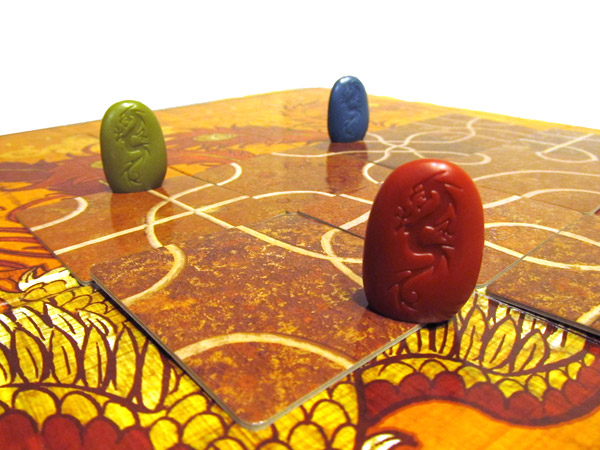Tsuro: The Path to Quick, Casual Fun

Tsuro: The Game of the Path is a quality casual game published by Calliope Games that has been in print for some time, yet nevertheless deserves a mention here if we are to call ourselves casual game enthusiasts. When explaining the concept of casual games back when we were first defining our cause, it was not uncommon to hear people say, "Oh, so a casual game is like Tsuro!"
Tsuro was often the first casual game to come to mind for those who were new to the concept of casual gaming, and for a good reason: it plays in 15 minutes, it can be taught in just a minute or two, and can be enjoyed by a broad audience of casual gamers.

Gameplay
Gameplay is quite simple. The game consists of 35 tiles containing various combinations of paths that are placed onto the game board in a grid formation. Each tile contains 4 paths and can be placed next to any other tile on the board, in any orientation.
At the start of the game, each player places a "marker stone" that marks his location on the board. On a turn, the current player selects one of the 3 tiles in his possession and places it next to his marker stone. When a tile is placed next to one or more marker stones, each stone progresses along its current path until it can go no further. If a stone reaches the edge of the board, the stone is removed and the player is eliminated. If two stones collide, both players are eliminated. The winner is the last player to remain on the board.
Review
Tsuro is a solid and high-quality casual game that offers simple game play, yet requires foresight and careful planning to come out victorious. Failure to plan properly can unintentionally place your stone precariously close to another player, giving them an opportunity to put you in a difficult situation or eliminate you entirely. The inclusion of player elimination could be frowned upon, but the game is over quickly enough to prevent boredom for the eliminated players.
In some ways, the game gives the feeling of a cat-and-mouse chase, with some players actively seeking out confrontation, while other players try to stay as far away as possible. However, whatever one's strategy may be, the ability to stay the course still requires planning and decision-making. Even if all players choose to avoid confrontation altogether, the number of tiles is limited and players will eventually face each other - assuming they don't run out of options and eliminate themselves first.
Pros: Easy to learn, difficult to master, high quality production value
Cons: Player elimination











Sounds like a perfect "casual game." I've seen this referenced a few times but didn't realized it was so simple and played so quick. I'll have to check it out!